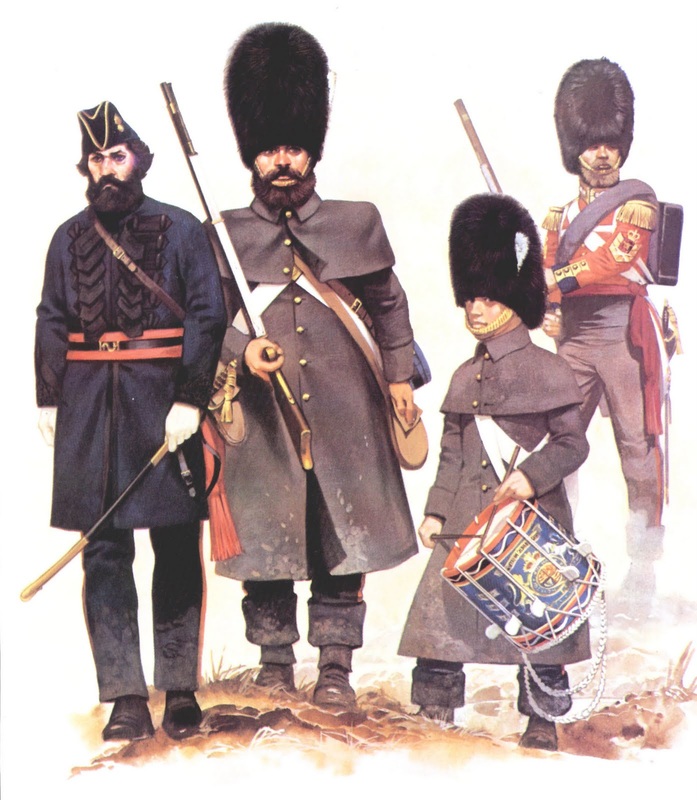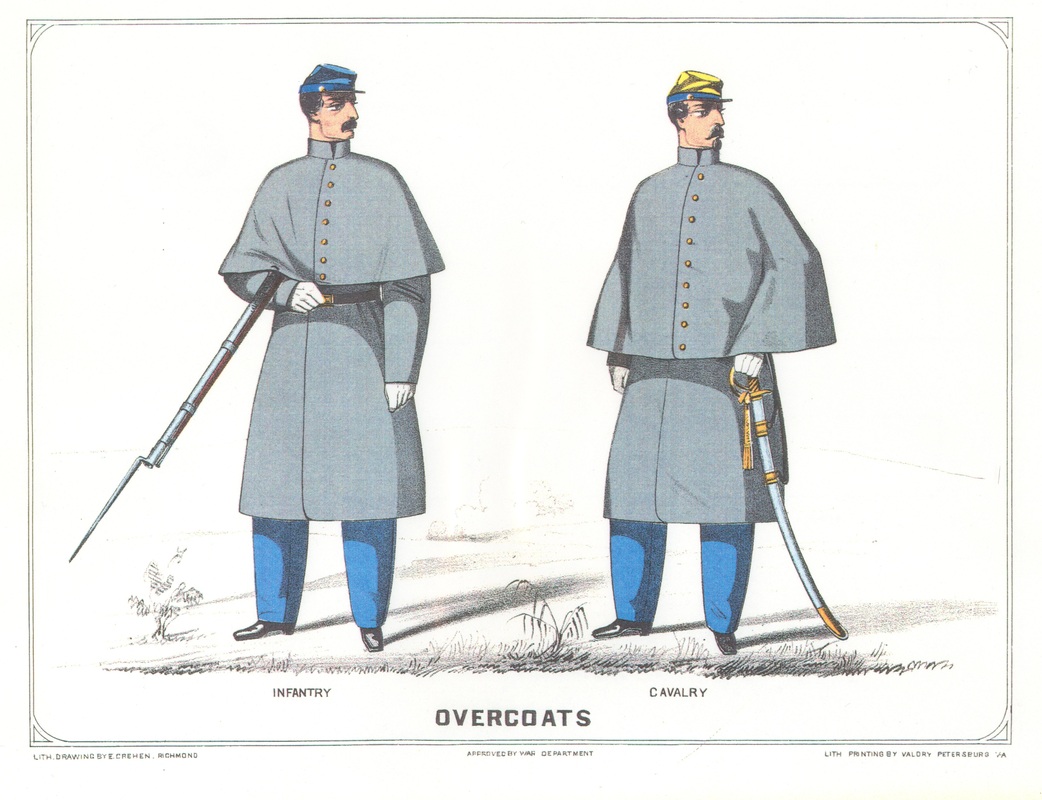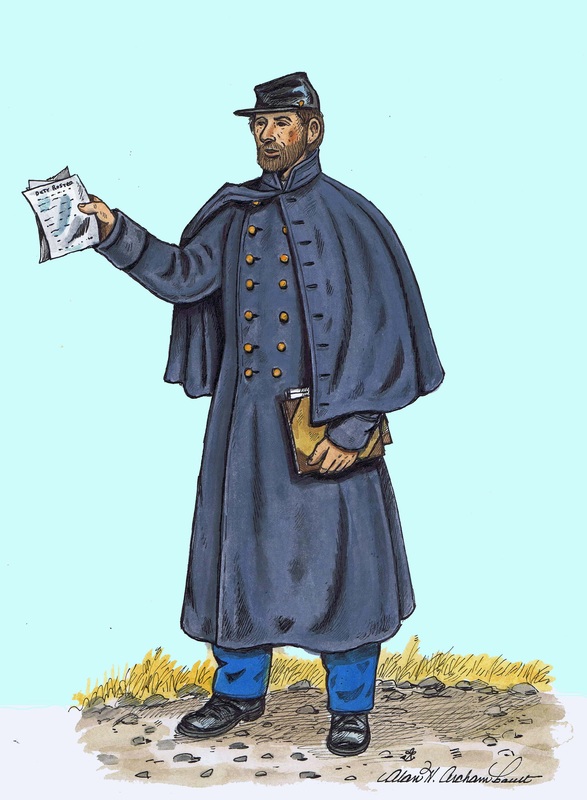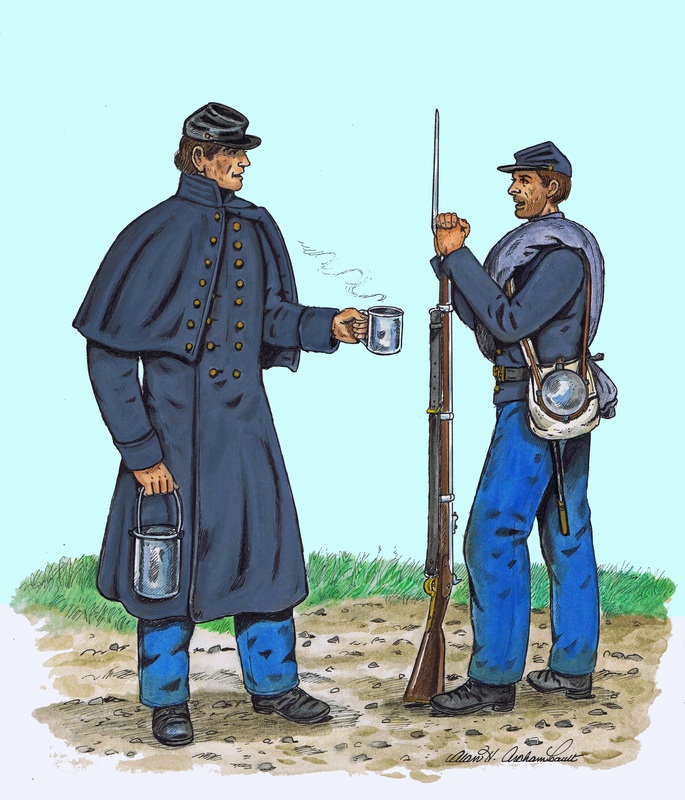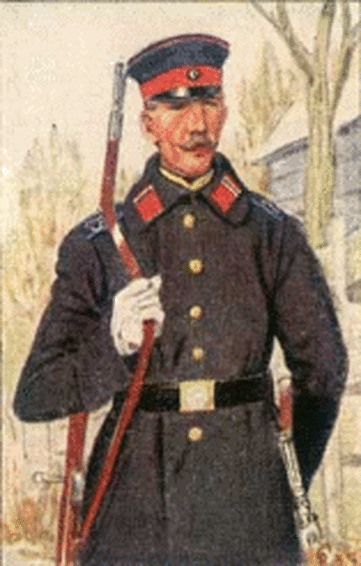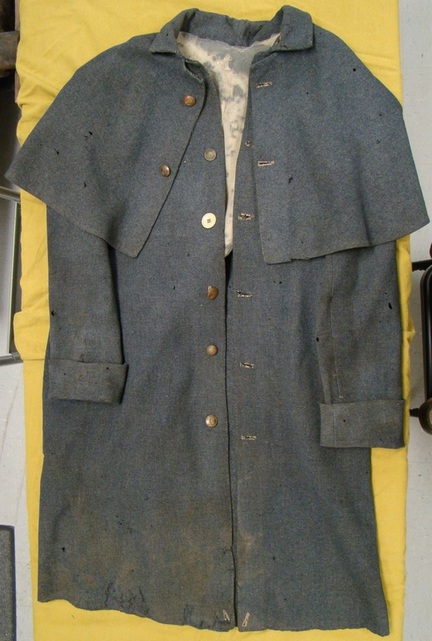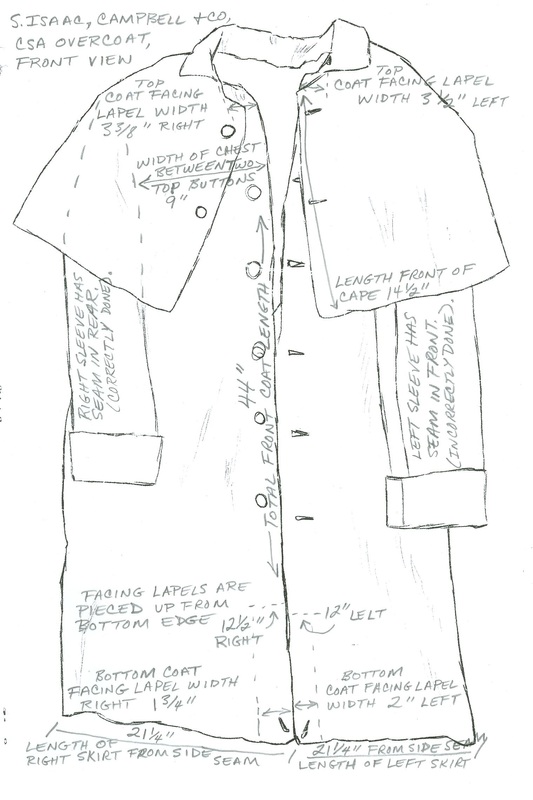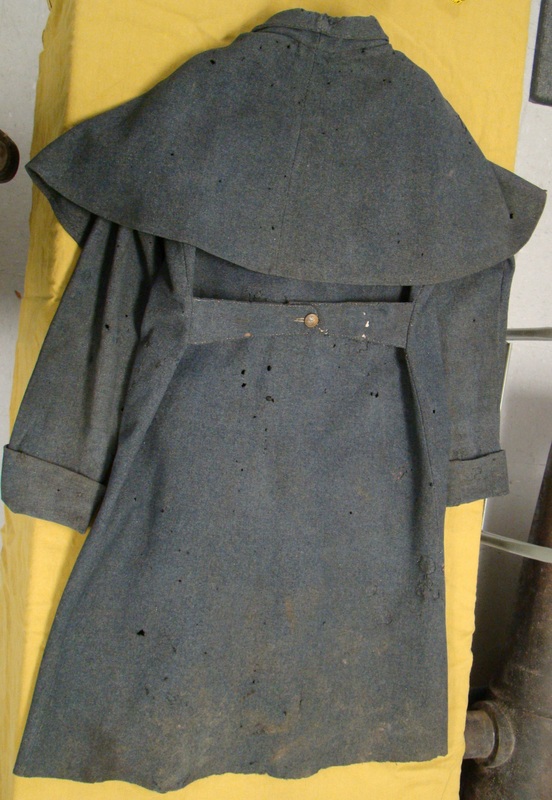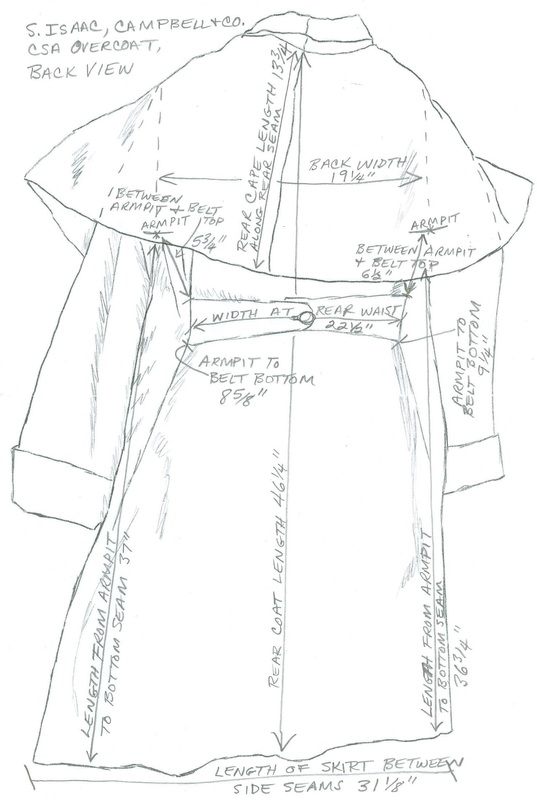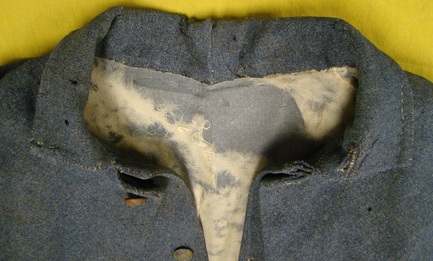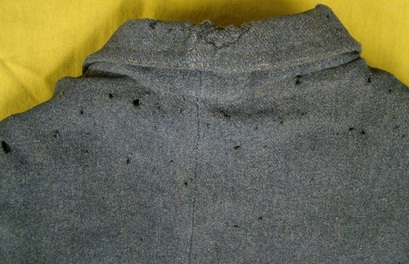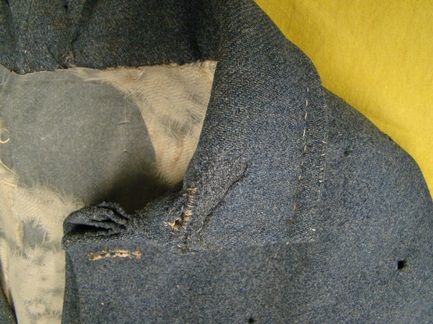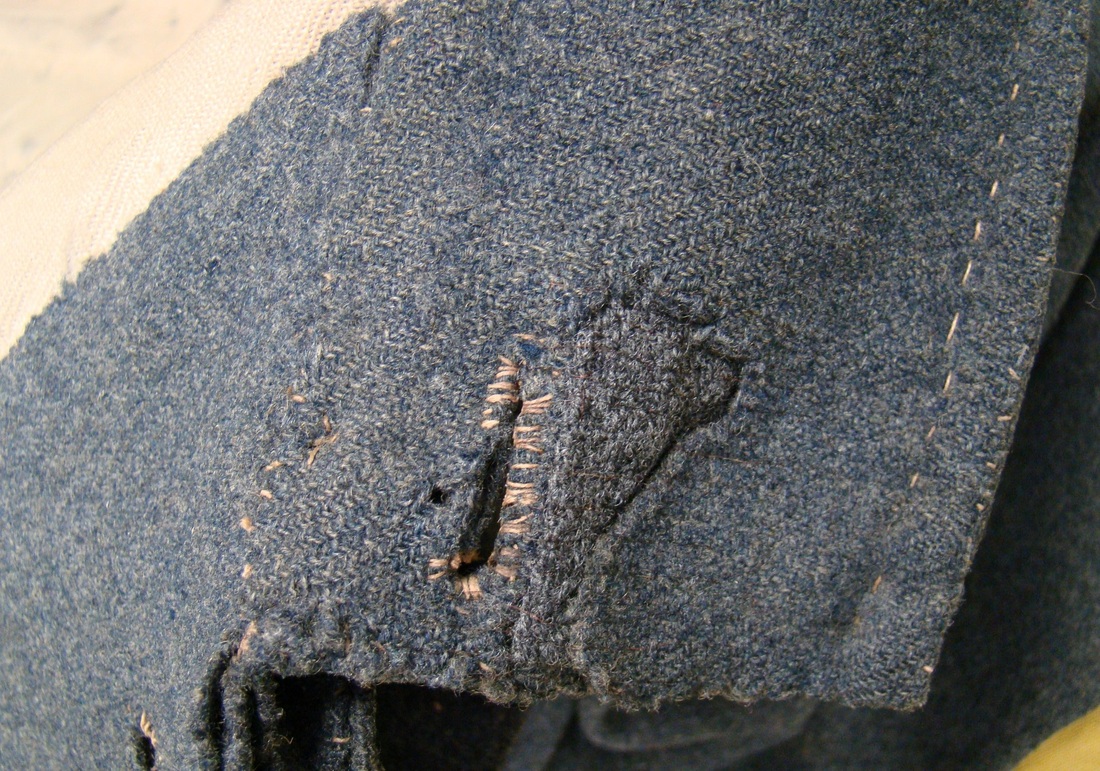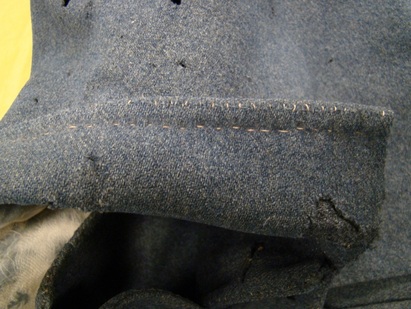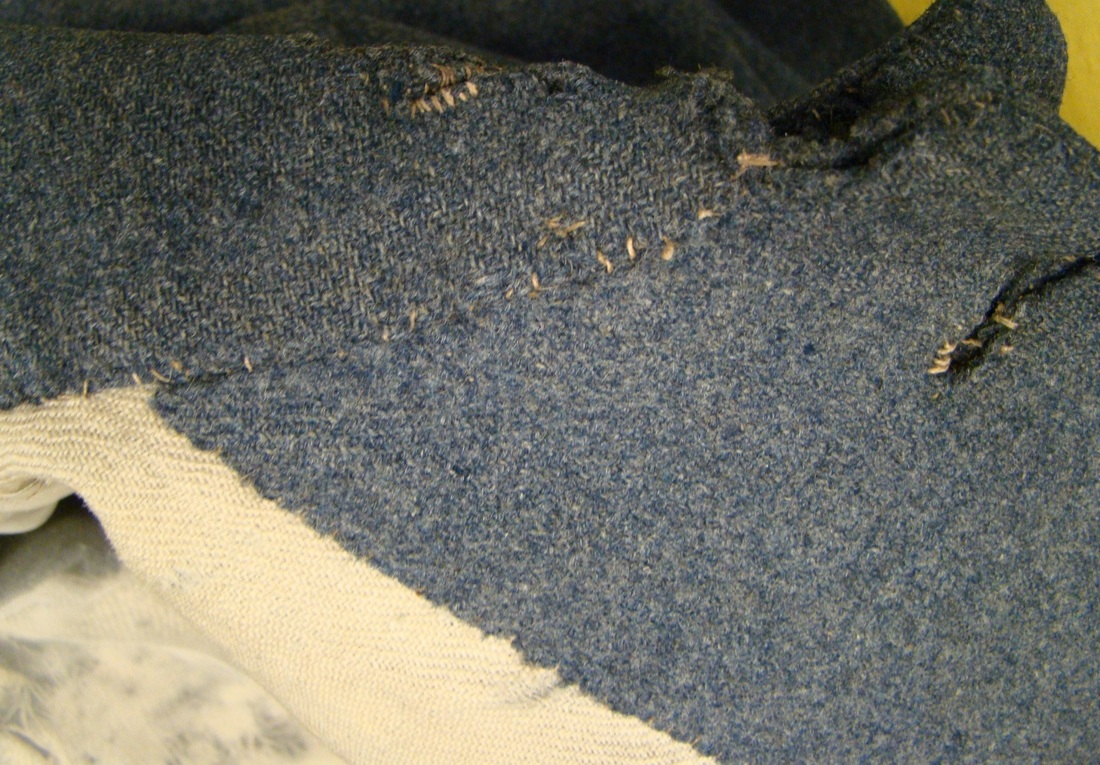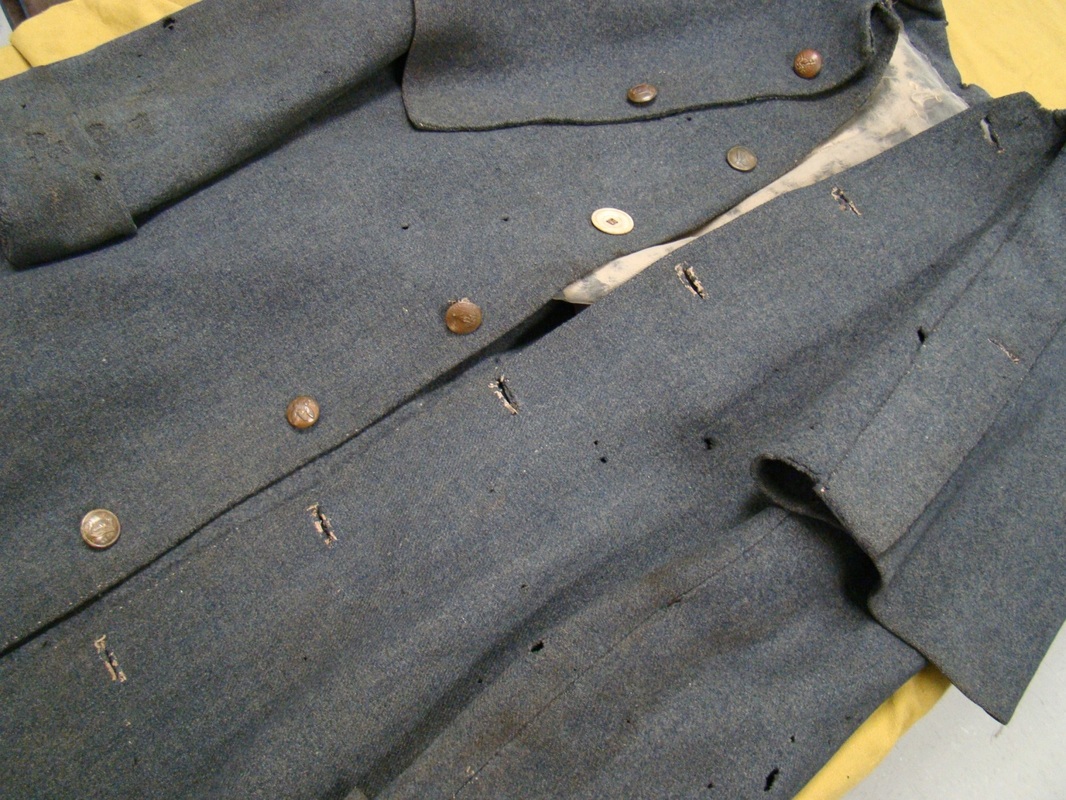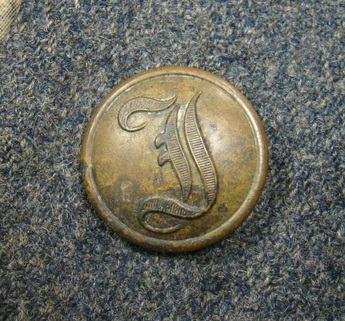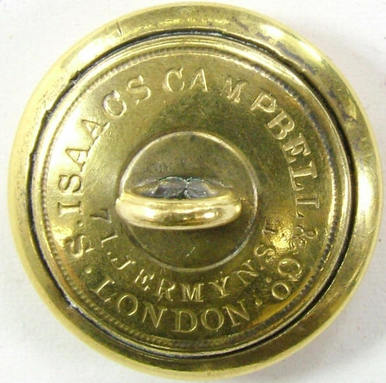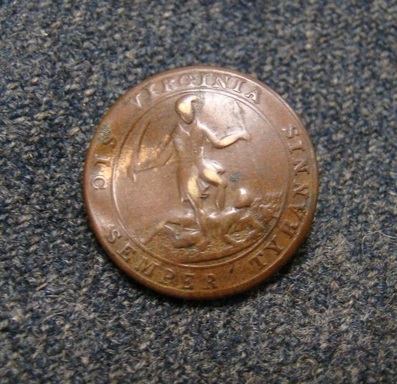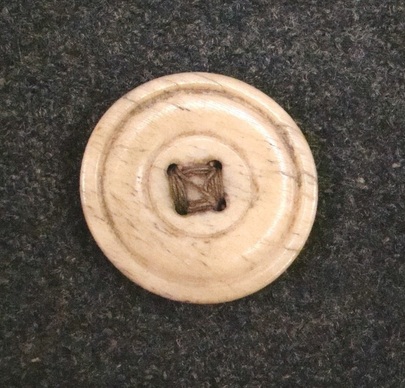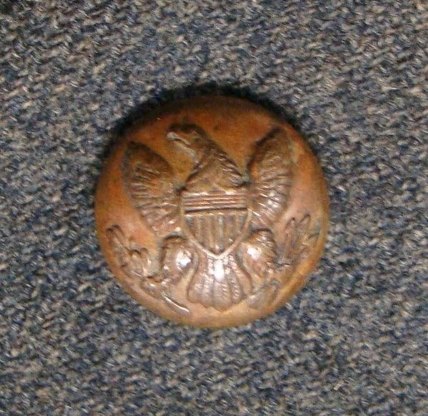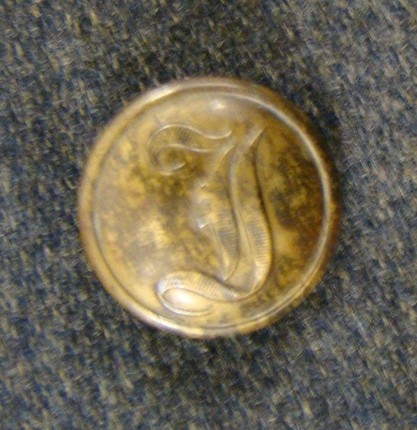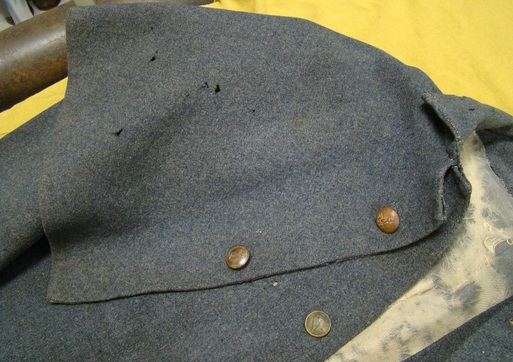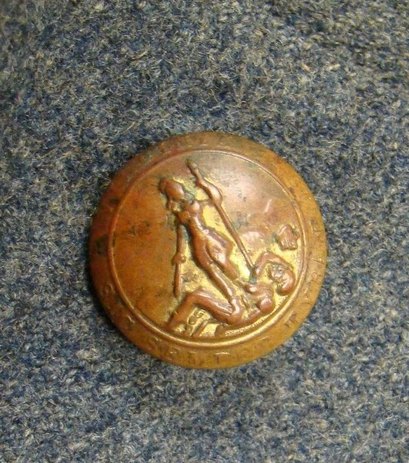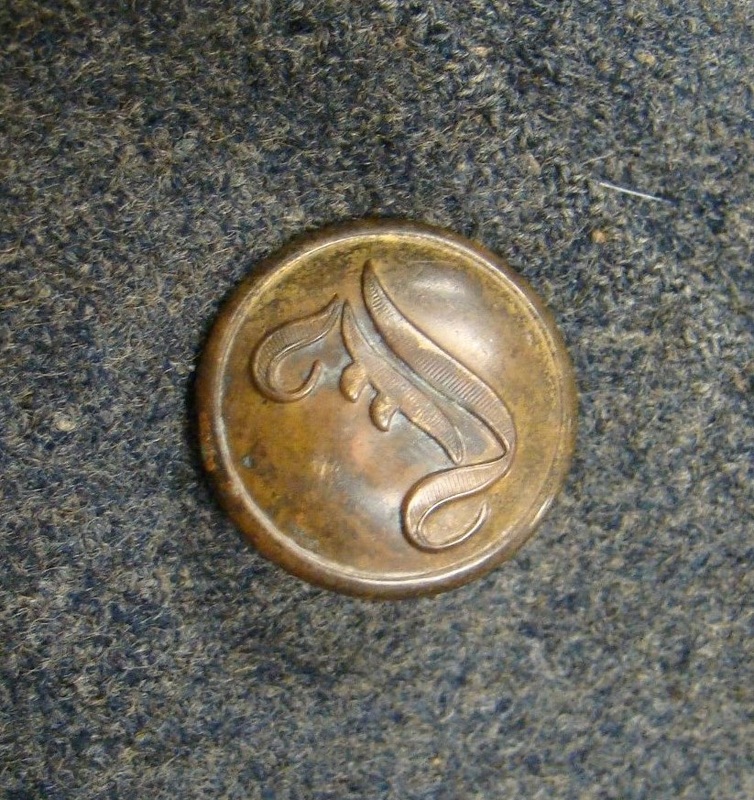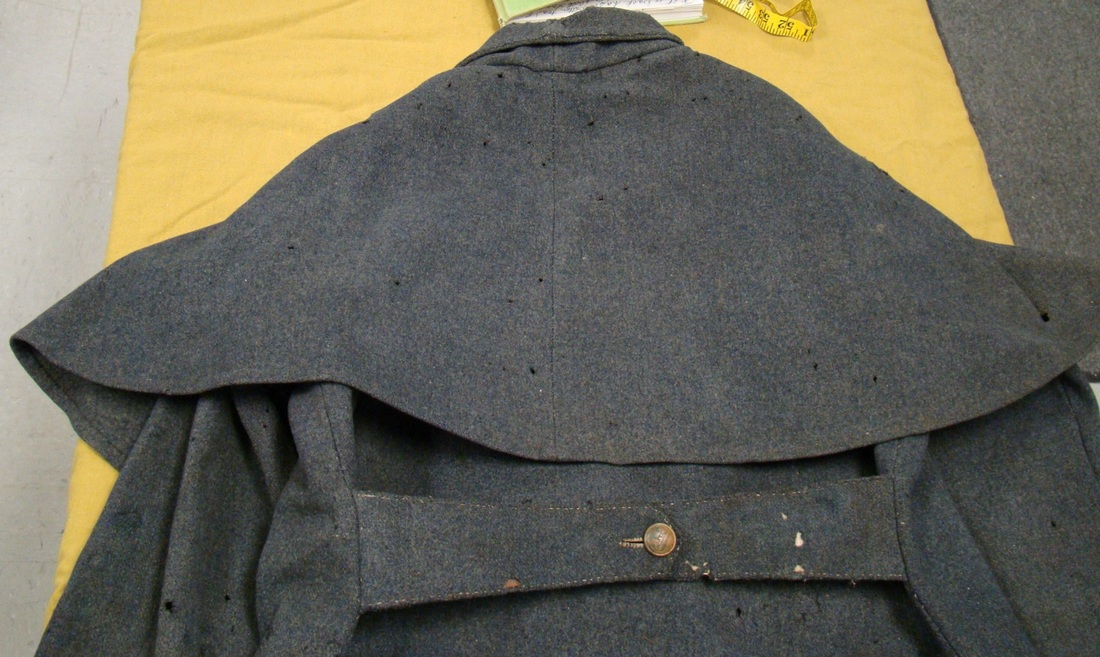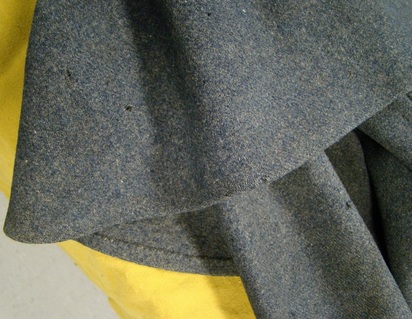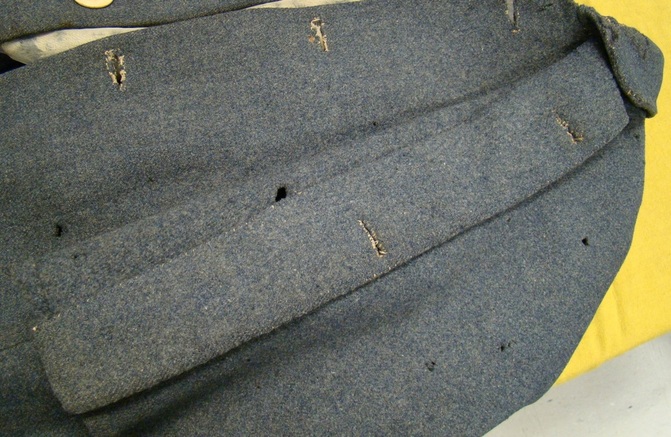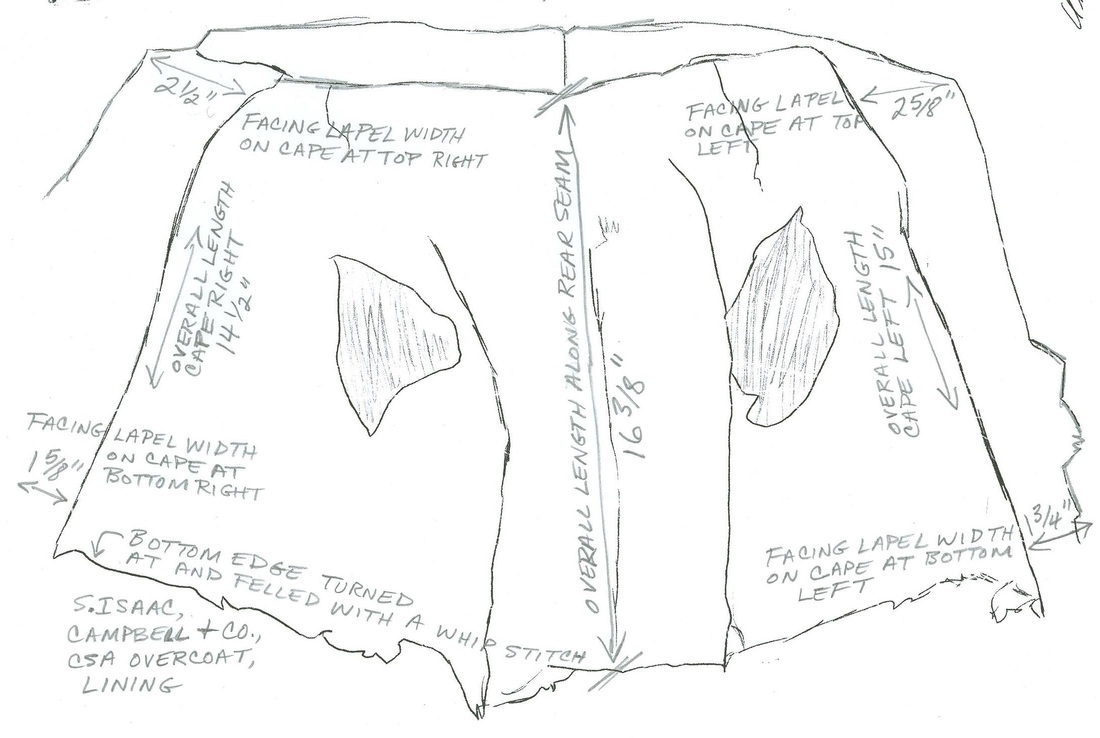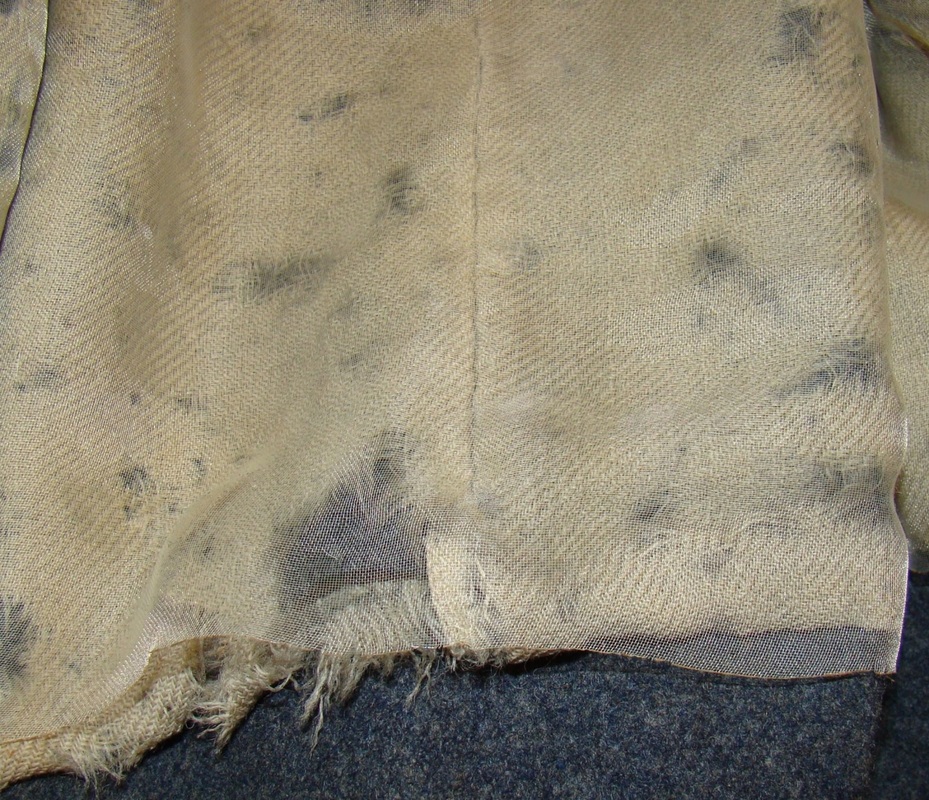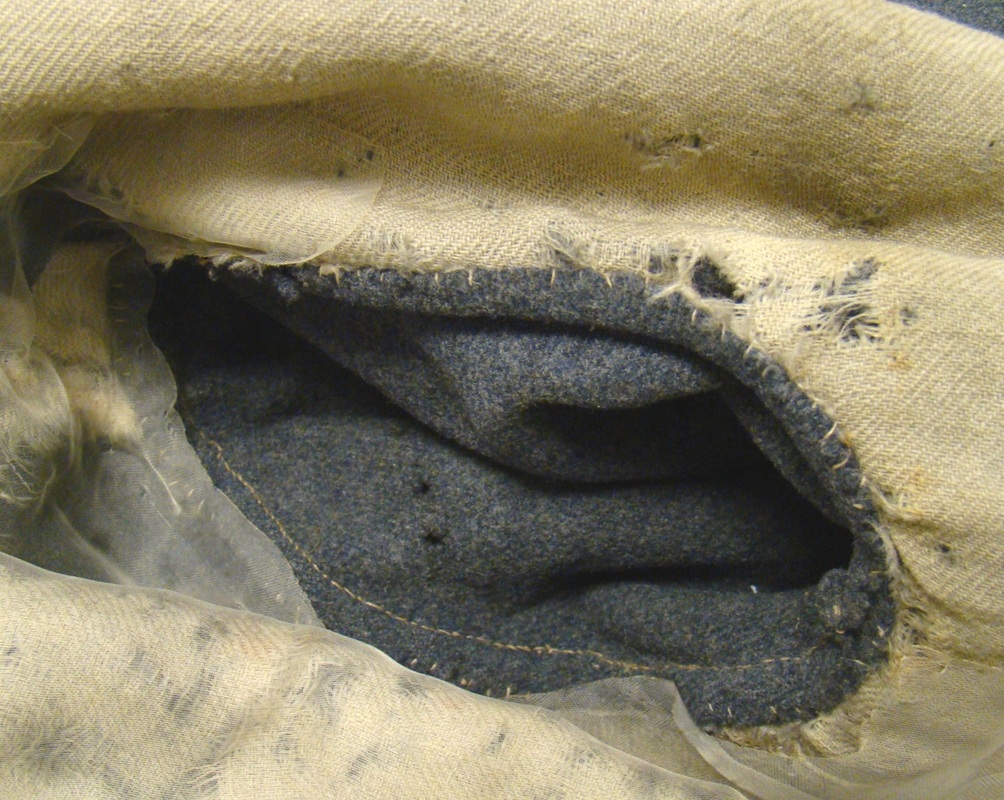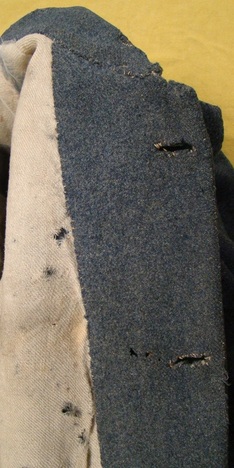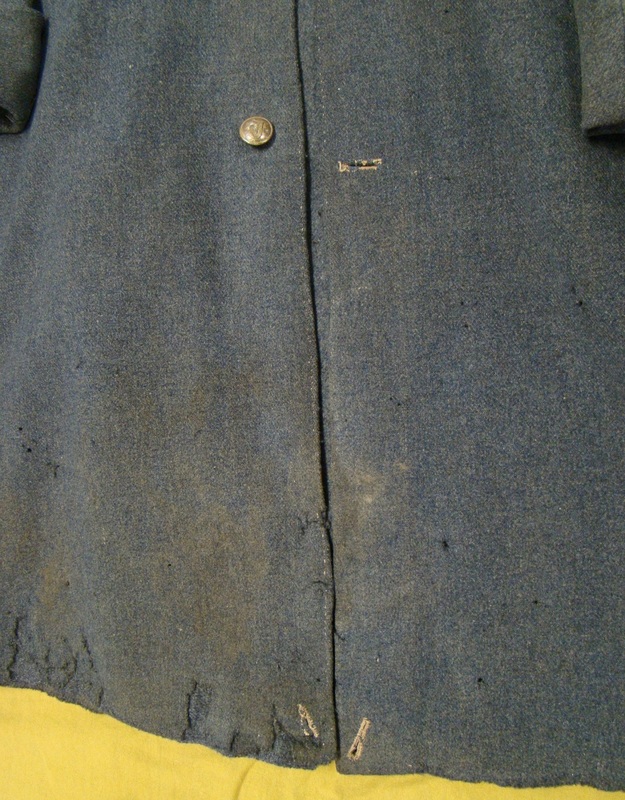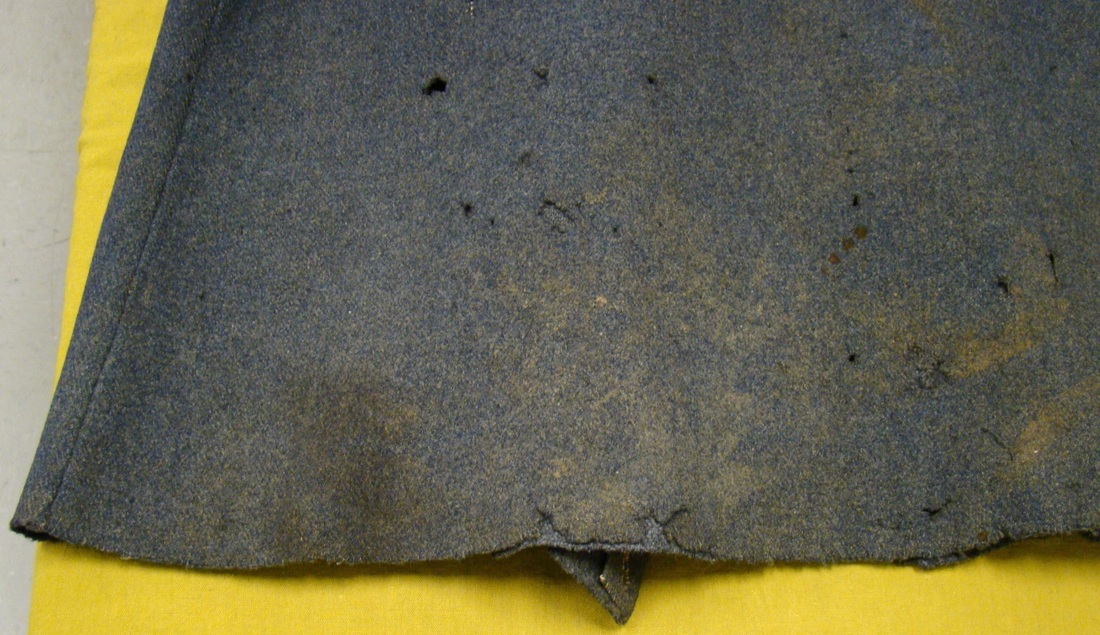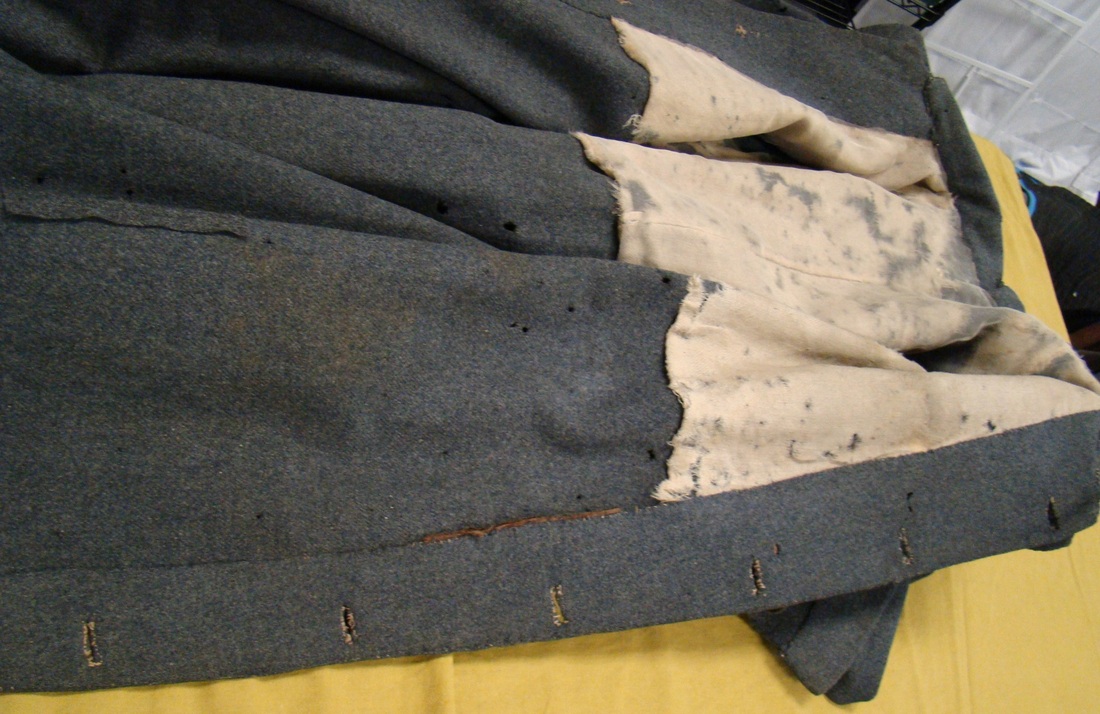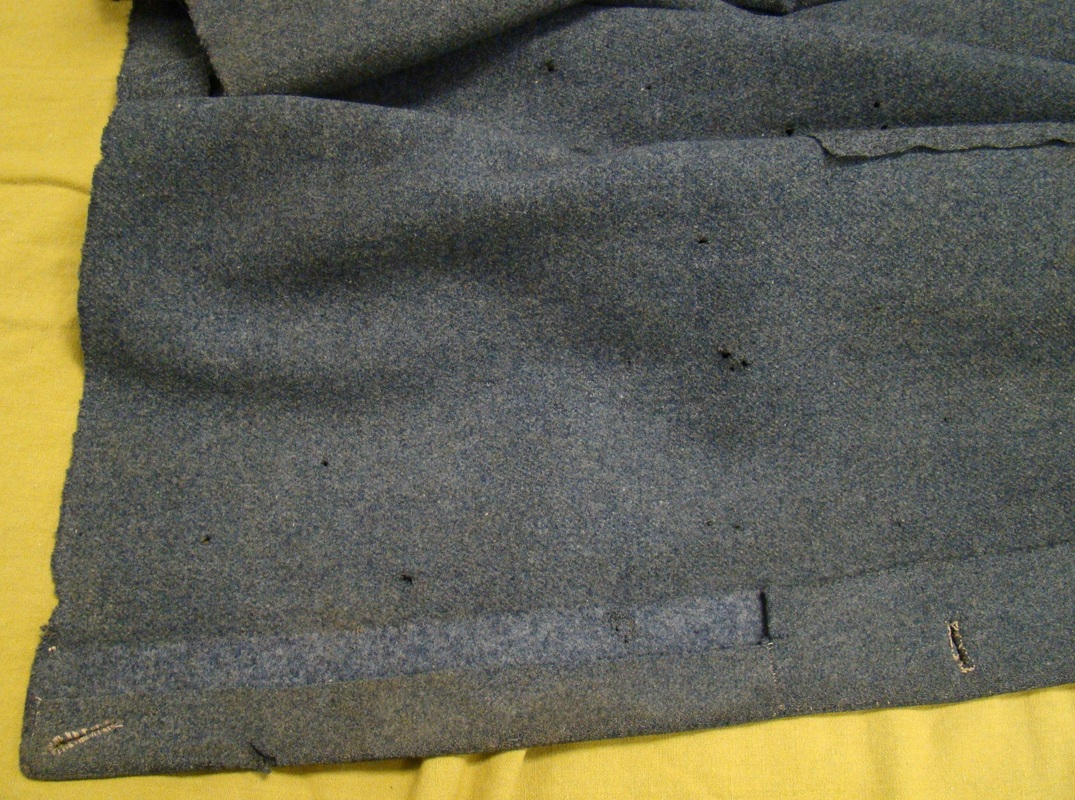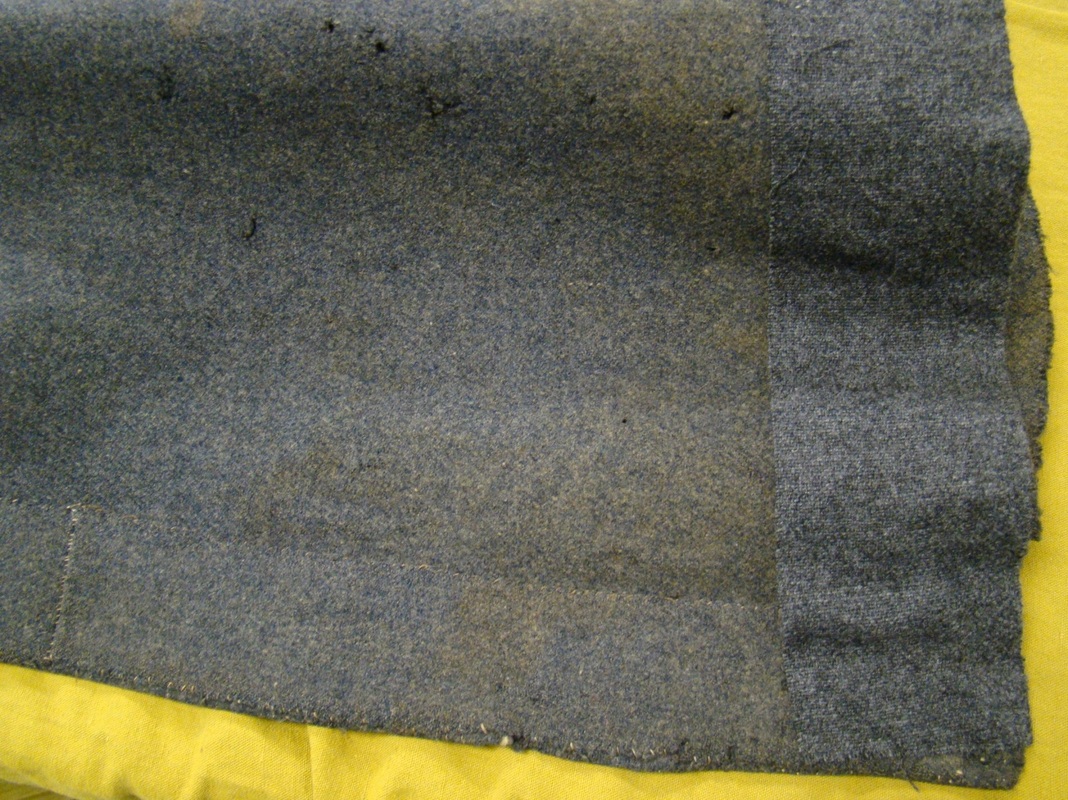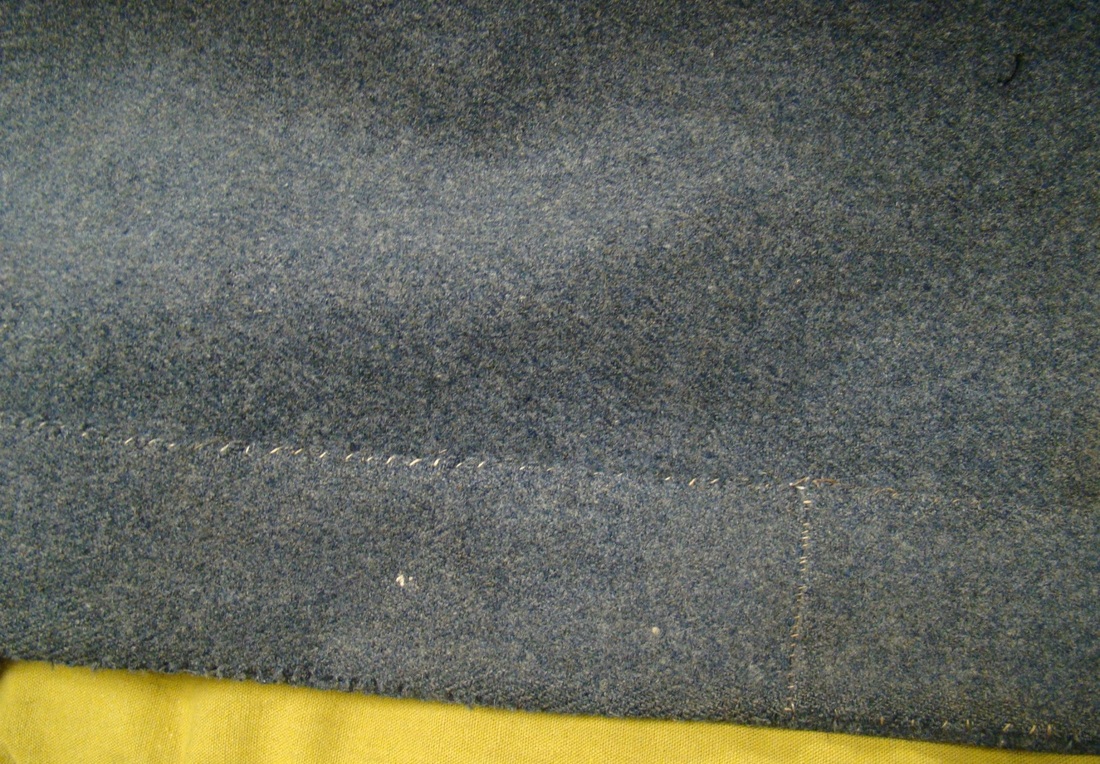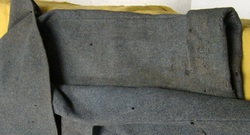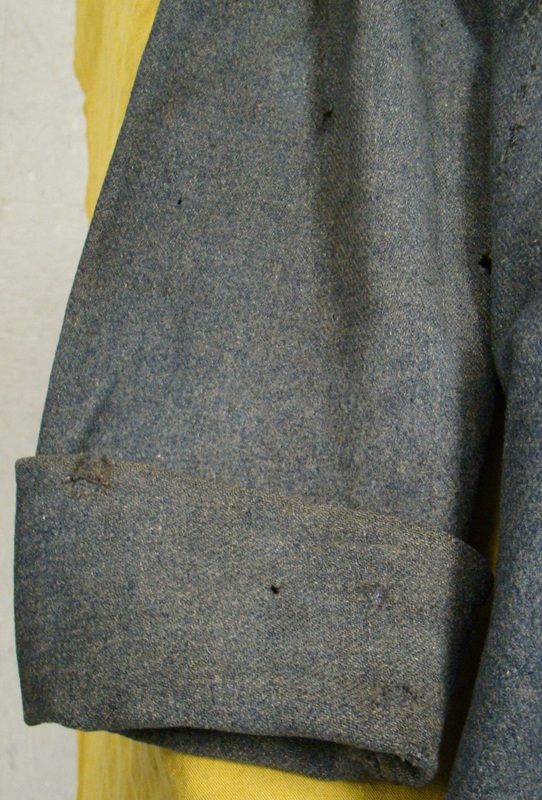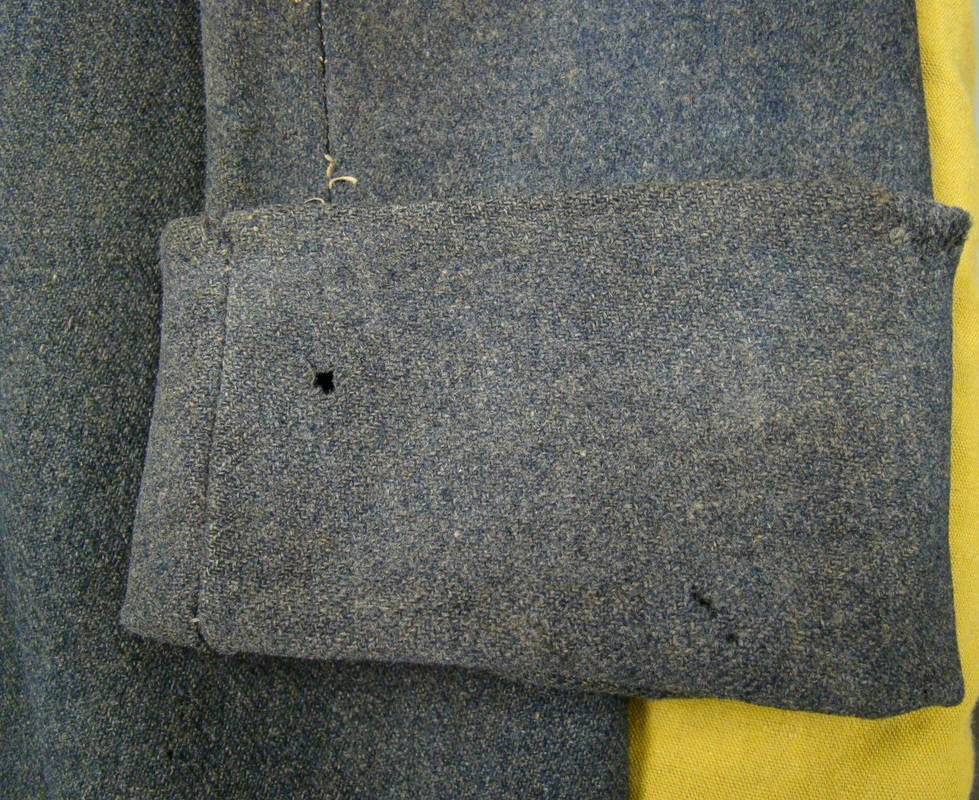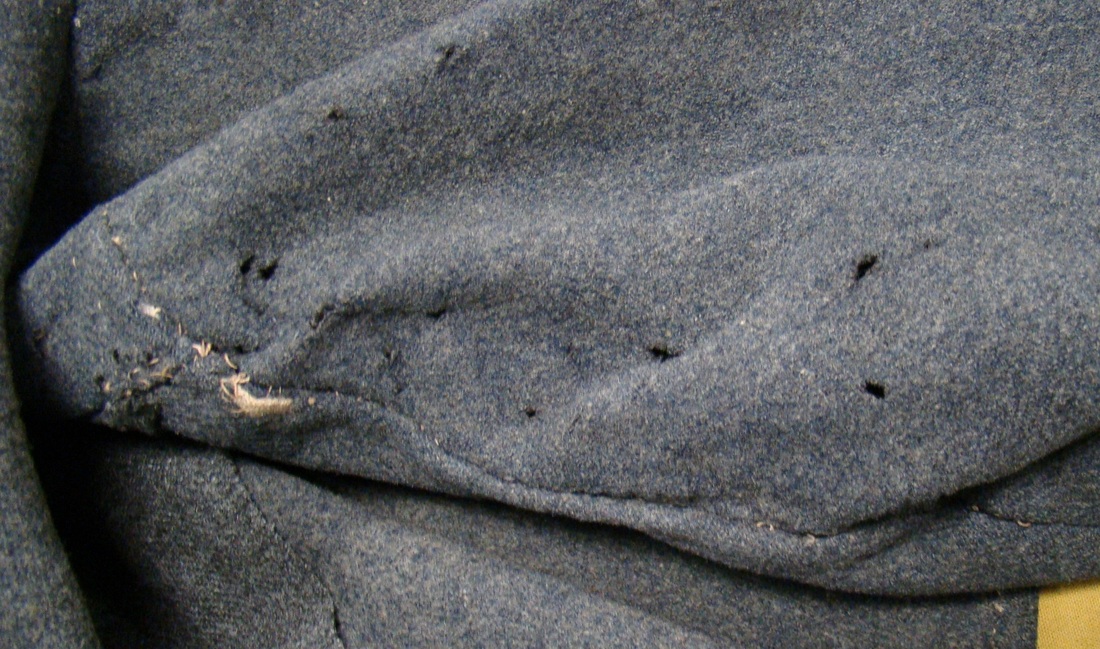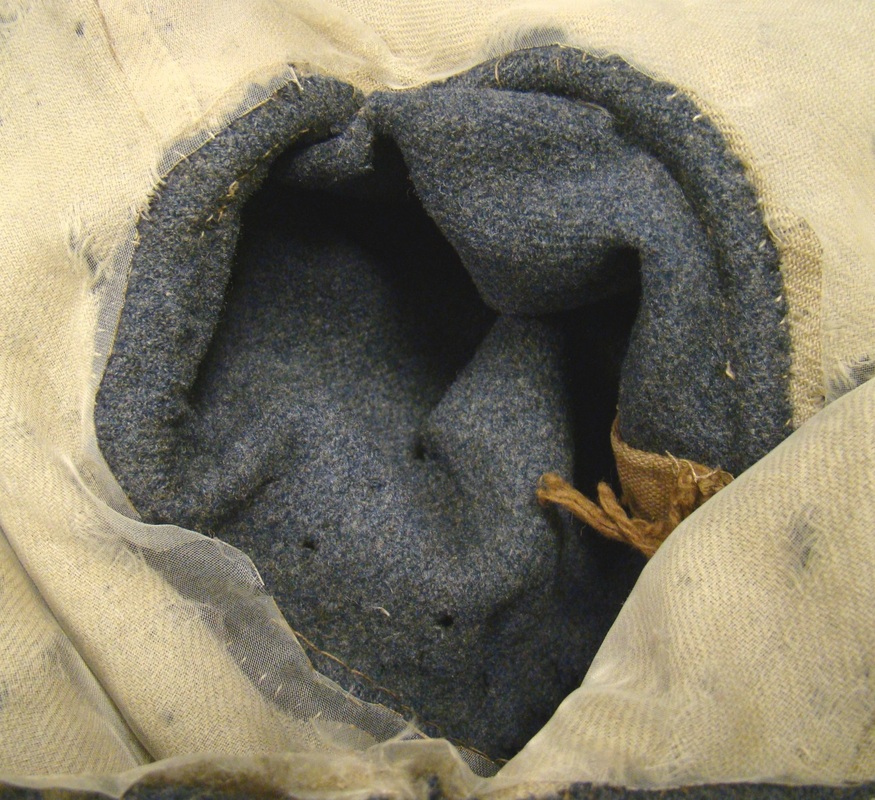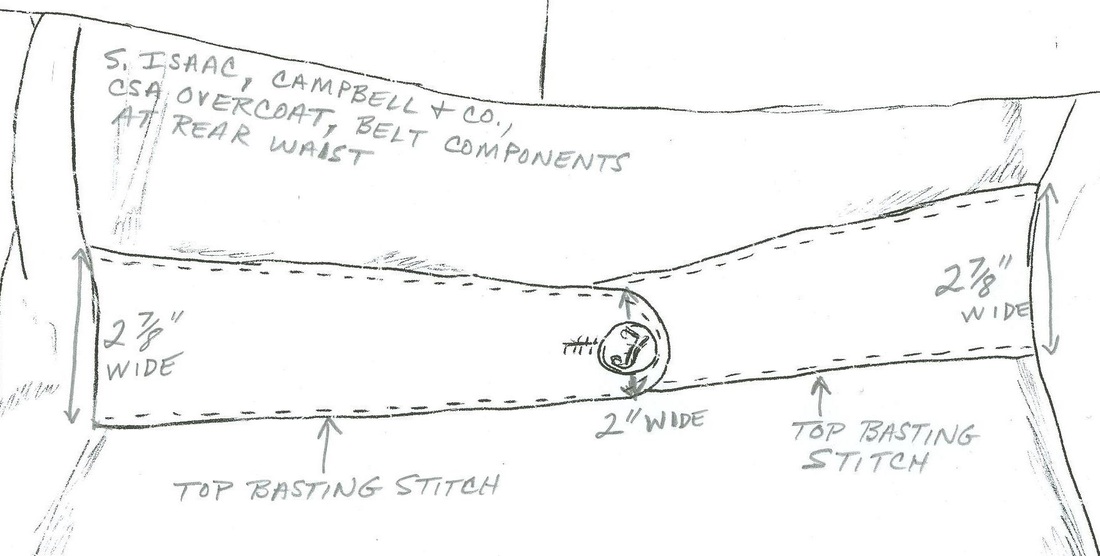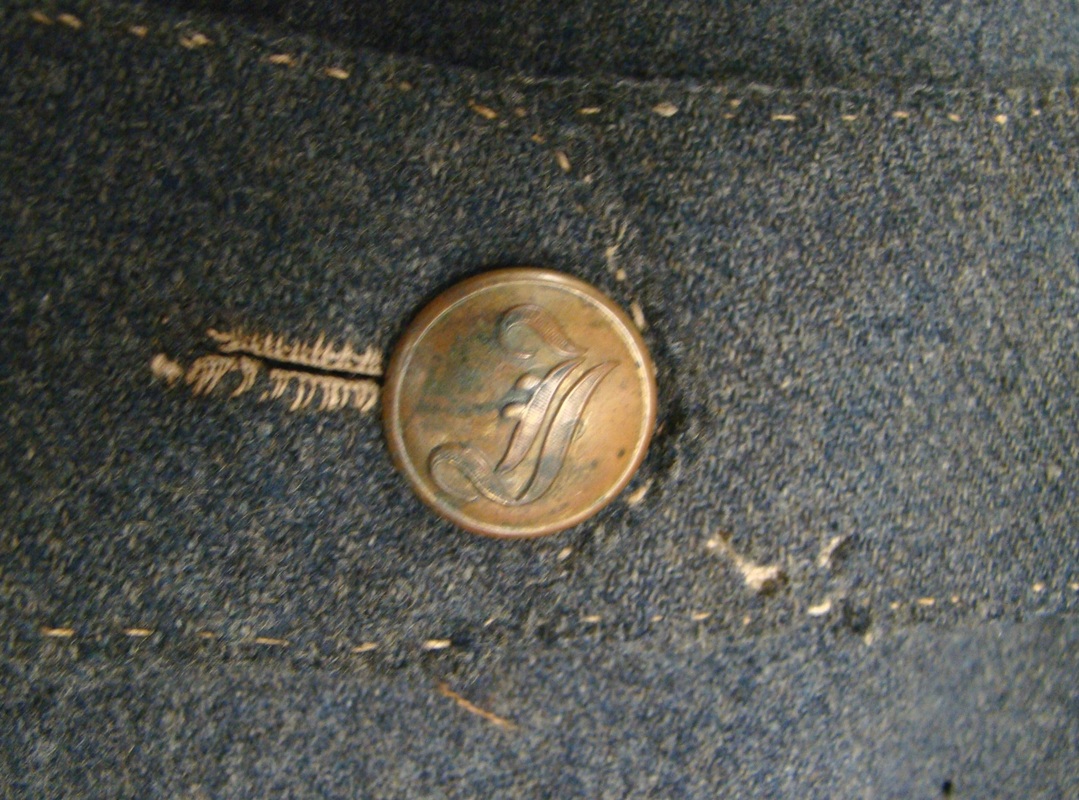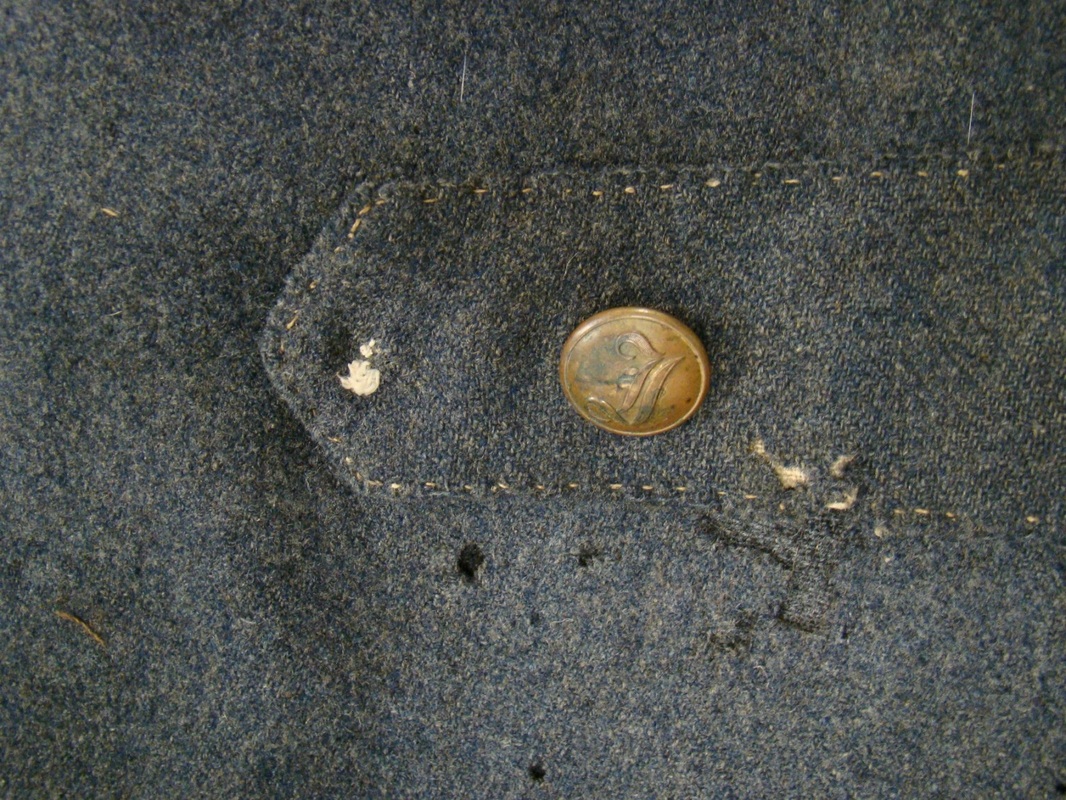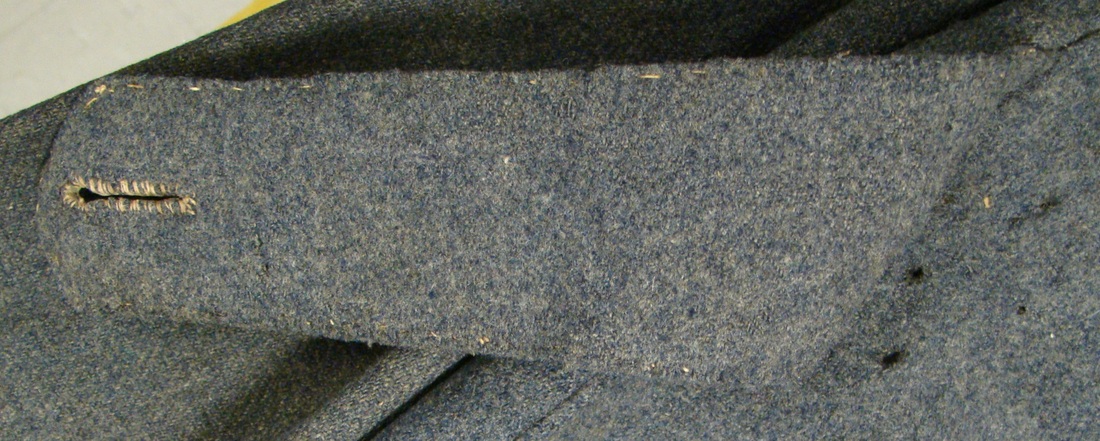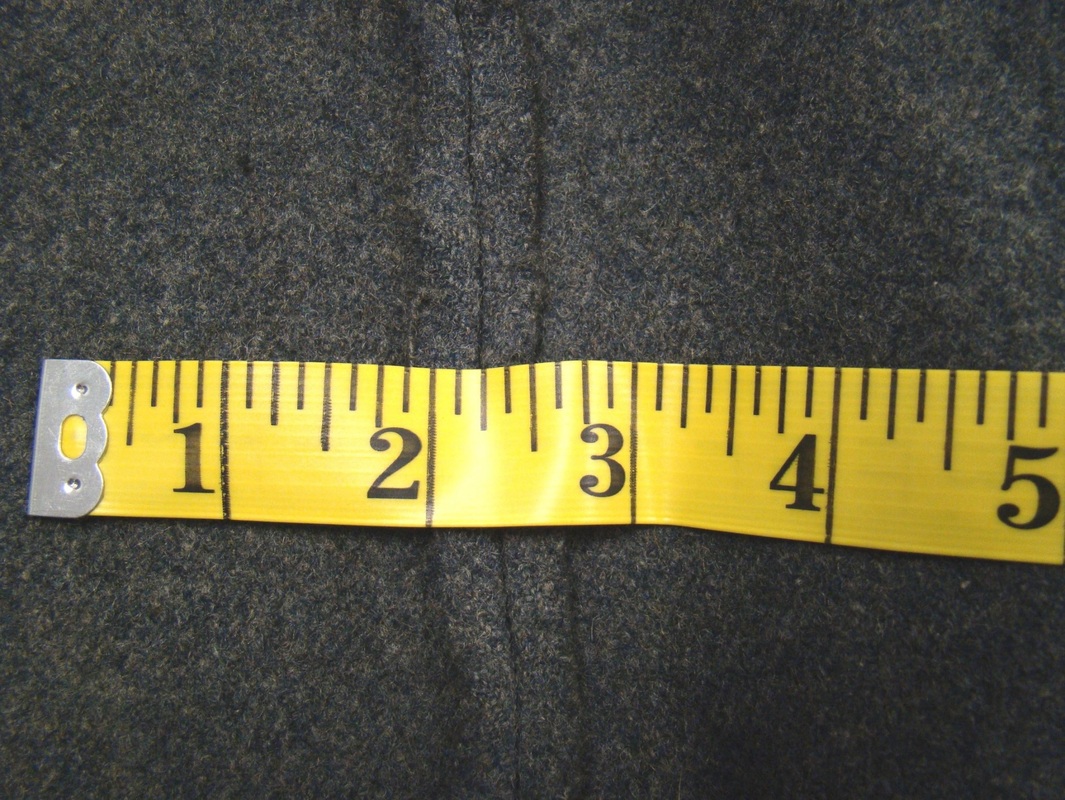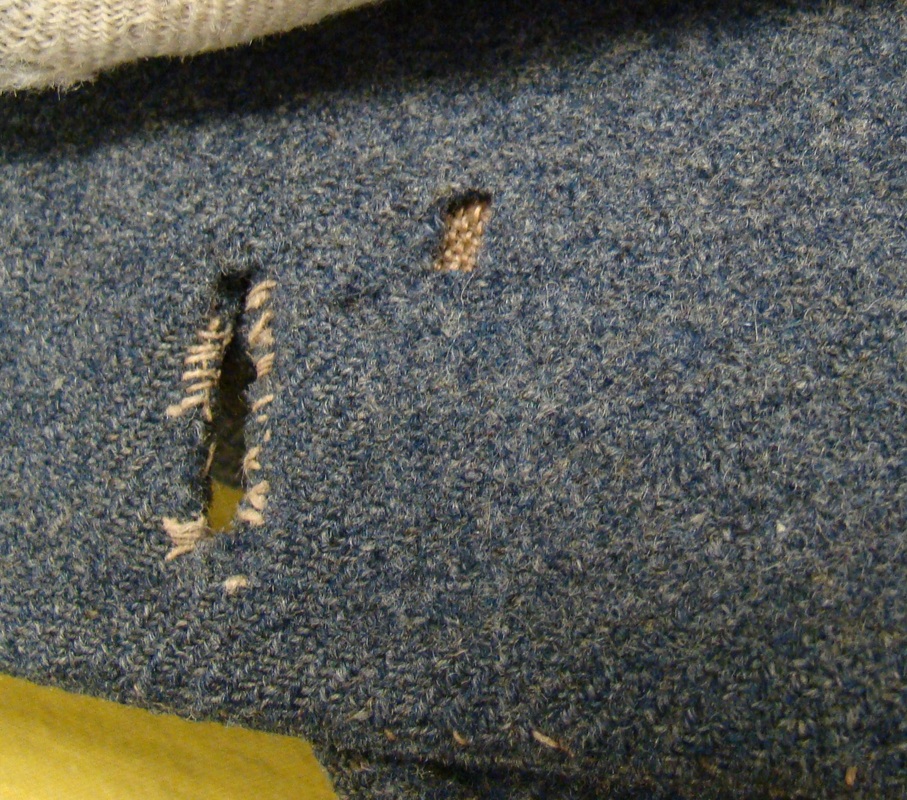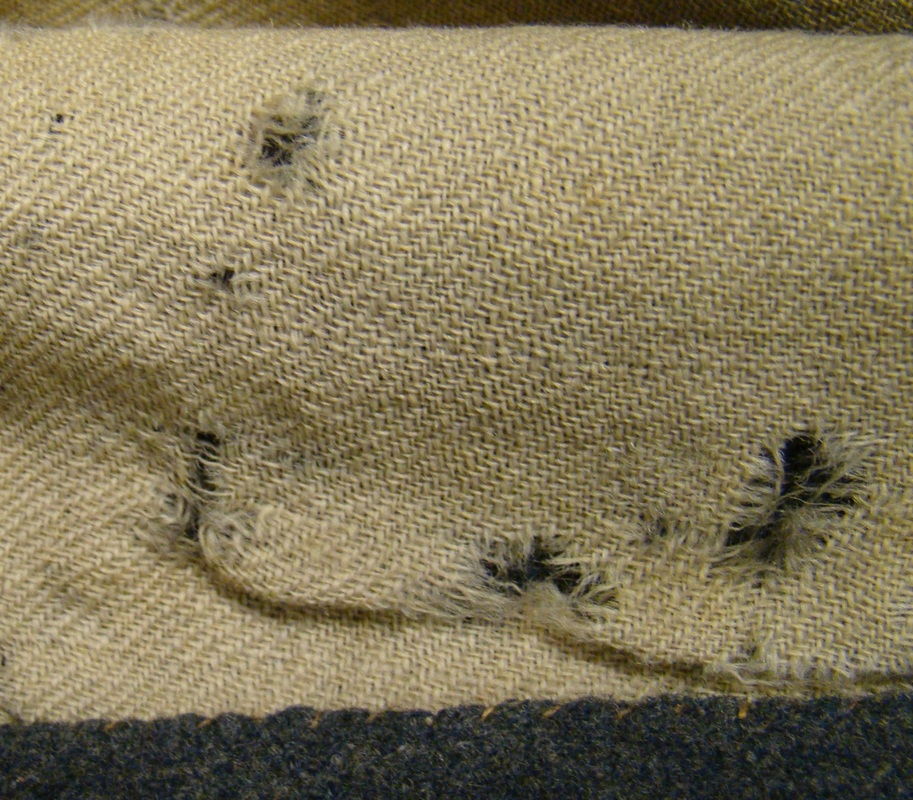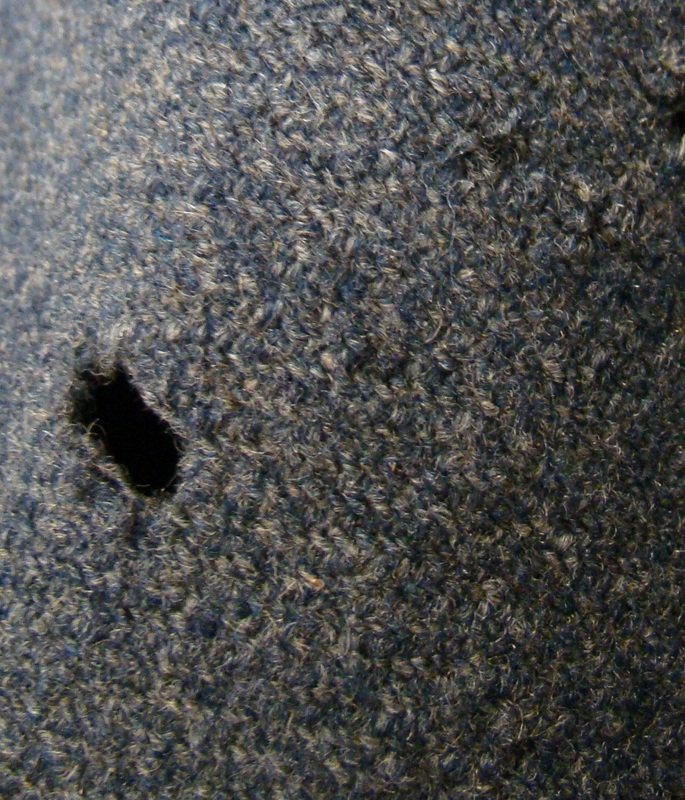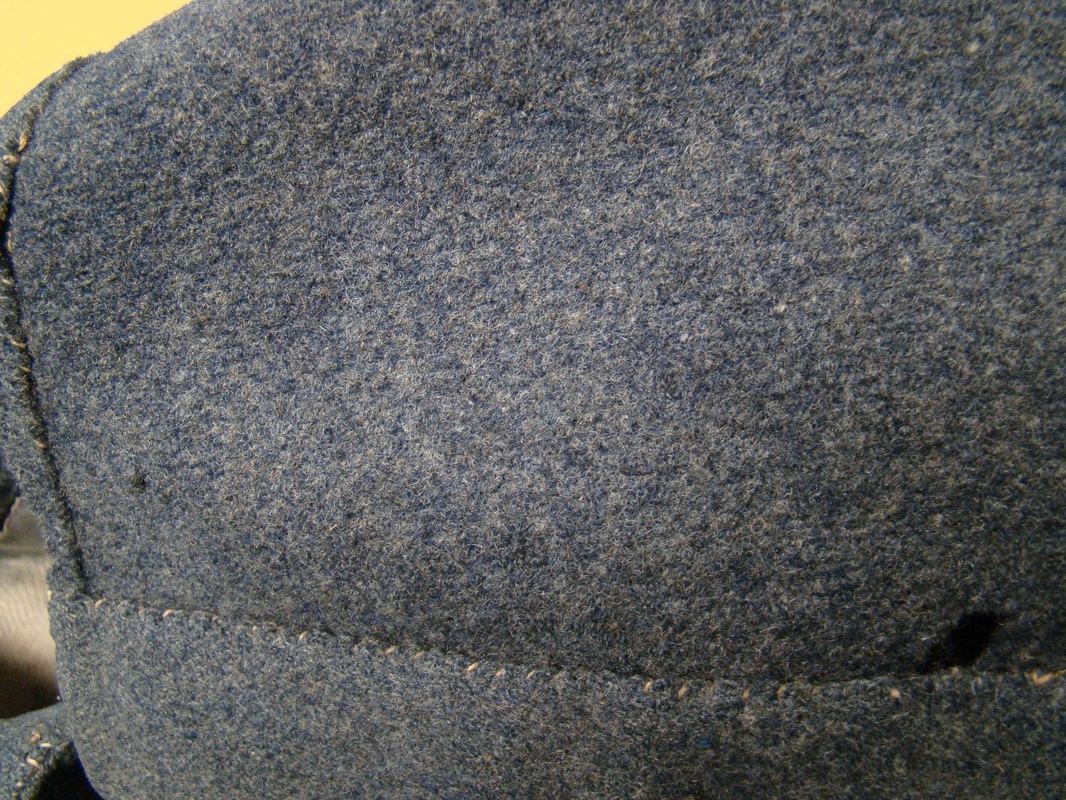The Imported British Overcoat for the Confederate Army
By Fred Adolphus, February 2014
Pennsylvania zouave Frank Rauscher provided the most
succinct, first-hand description of the imported Confederate overcoat of the
Civil War. Rauscher commented in
December 1863 that in Virginia, “The [Confederate] prisoners here taken were
better clothed than any we had before seen; all were provided with overcoats
and jackets of much better material than our own. They were of English manufacture, a much
darker blue than the U.S. [sky blue overcoat] and they furnished conclusive
evidence of successful blockade running.”
Rauscher was probably describing the dark, blue-gray kersey, S. Isaac,
Campbell & Company overcoat issued to the Army of Northern Virginia
that closely resembled the standard British army overcoat. One of these S. Isaac, Campbell overcoat survives
today in the Texas Civil War Museum collection in Fort Worth, Texas.[1] However, the S. Isaac, Campbell overcoat was just one
of many imported into the Confederacy from abroad.

Image 2: The artist's rendition of the S. Isaac, Campbell overcoat by Company of Military Historians Fellow Alan H. Archambault, depicts the coat as it would have appeared when worn by a soldier of the Army of Northern Virginia. The author described the coat to the artist before he had a chance to examine it thoroughly, therefore, the artwork may contain some slight differences with the original. Any discrepancies are entirely the fault of the author.
The most salient feature of the surviving S. Isaac,
Campbell overcoat is that it mirrors the British army overcoat, not the
Confederate army regulation greatcoat.
This is understandable for several reasons. The British coat was blue-gray kersey which
matched the Confederate uniform color perfectly. Its tailoring was not only simpler than the
elaborate, Confederate regulation overcoat, it was already standardized within
the British uniform industry. Therefore,
it required no additional set-up time to manufacture, and could go into
immediate production.
By
contrast with the British pattern, Confederate uniform regulations called for
two different types of enlisted overcoats. Both were to be made of cadet gray cloth, double-breasted
with a stand-up collar, a cape, and to button all the way up with eighteen
buttons (presumably nine buttons per row).
The cape on the overcoat for mounted men was to reach to the cuff when
the arm was extended, and the cape for footmen was to reach to the elbows when
the arm was extended. Accompanying sketches
show that the mounted overcoat cape buttoned with a single row of nine,
small-size buttons, and that the foot overcoat cape buttoned with a single row
of seven, small-size buttons. Neither
overcoat was depicted with French cuffs.[2] That the British army-style overcoat was
single-breasted represented an enormous savings in time and materials in
manufacture.
Despite
that, two surviving contracts call for double-breasted great coats that closely
follow the Confederate regulations. Mr. John Chiles
of St. Louis, Missouri agreed to import at Brownsville, Texas by November 1,
1863, 30,000 great coats for $20.00 apiece.[3] The contract called for an entire array of
clothing that included, “Thirty
Thousand Great Coats suitable for enlisted men in the service of the
Confederate States Army, to be made of Cadet Grey cloth, stand up collar,
double breasted, cape to reach the cuff of the coat sleeve when the arm is
extended, and to button all the way up, one pocket in the left breast facing,
one pocket in each fold of the skirt, edges of the skirt to be filled and
stitched, so as to make what is termed “smelled [felled?] edges”, two rows of buttons on
the breast seven in each row, the buttons to be military brass buttons; the
distances between the rows four inches at the top and three inches at the
bottom, the coat to average forty-four inches in length from the top of the
collar to the lower edge of the skirt, also average from forty-two to forty-six
inches in size measuring around the breast, and to be lined through the body
with heavy Linsey cloth, and through the sleeves with good serviceable twilled
flannel or twilled cotton cloth.” The
delivery date was postponed, undoubtedly since Federal forces occupied
Brownsville in November 1863.
Nonetheless, the 30,000 complete uniforms were awaiting delivery in
Matamoros on June 10, 1864, and were apparently moved into Texas shortly after
the Confederates liberated Brownsville on July 29, 1864.[4]
Another
Trans-Mississippi contract, made with Mr. John T. Chidester (or possibly Chichester) of Camden, Ouachita County,
Arkansas, on June 12, 1863, called for
another 30,000 uniforms. These were to
be delivered on or before January 1, 1864 either in Arkansas or on the Texas
coast.[5] Aside
from the other uniform components, the agreement called for, “30,000 Great
Coats for enlisted men of the Confederate States service, of Cadet Grey cloth,
or dark blue or black English beaver cloth, stand-up collars, double breasted,
cape to reach to the elbow when the arm is extended, and to button all the way
up (buttons eighteen), lined through the body with Linsey and through the
sleeves with brown drilling at $15.00 each.”
While no records have been found confirming delivery, the uniforms were
certainly delivered since Chidester became very wealthy by 1864: a sure
indication that he was paid for completing the contract.
C.L. Webster III’s impressive work, Entrepot, provides a
wealth of data on how many overcoats were imported into the Confederacy.[6] As early as late April 1862 blockade runners
were delivering “Military Grey Overcoats, English Regulation” to
Wilmington. Later, in February 1863,
Gorgas reported that Confederate purchasing agent Caleb Huse had already
shipped 8,675 greatcoats, with an additional 14,250 awaiting shipment in
London.[7] Blockade runners delivered more overcoats to
Wilmington in May 1864. A total of 178
bales of overcoats and pants arrived on May 16, 1864, and another 15 bales of
overcoats arrived on May 28, 1864. The
May deliveries were S. Isaac, Campbell goods.[8] Furthermore, the State of North Carolina
imported 6,000 overcoats through in mid-September 1864.[9] In January 1864, the Confederate
government made an agreement with
Rosenburg & Haiman Bros. & Co. to deliver 100,000 suits of clothing,
consisting of jacket, pants, overcoat and shoes, made in Germany “in quality
like that furnished the Prussian government.”[10]
Whether any overcoats were delivered under this agreement is unknown, but a
portion of the contract was delivered prior to July 1, 1864, and may have
included some overcoats.[11]
Finally, the most noted of foreign uniform manufacturers for
the Confederacy, Peter Tait & Company, offered greatcoats. As early as December 15, 1963, Tait offered
to make for the Confederate quartermaster, “50,000 Great Coats of Stout Grey
Cloth cut ready for sewing (fast dye),” at 12 shillings each. He sold the State of Alabama an unknown
quantity of these pre-cut, greatcoat sets in 1864. While the exact quantity is not known, they
numbered into the thousands since every Alabama State Troop received one, many
Alabama Confederate troops received them, and there were hundreds of private
sales of overcoats to Alabama officers at $130.00 per "Over Coat." By mid-October 1864, Tait had 11,500 finished
greatcoats ready for shipment to Confederate authorities that were in all
likelihood dispatched to the Confederacy soon thereafter.[12] Furthermore, based on a photo of an Alabama officer (see image below), the Tait overcoats wear cut along the lines of the British army, and S. Isaac Campbell and Company overcoats. This follows suit, as the Tait jackets were cut to the pattern of the British army tunic.
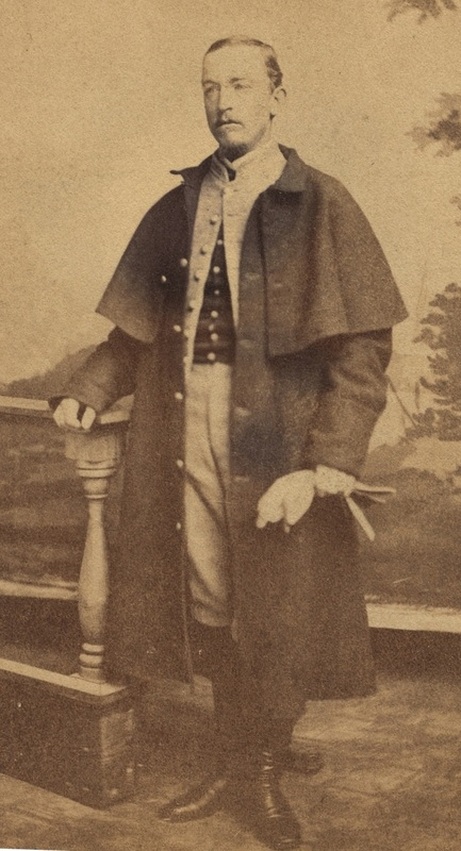
This image of Captain Edward Brett Randolph, 7th Alabama Cavalry shows him wearing a six-button front overcoat that is a perfect match with the S. Isaac Campbell & Company model. In fact, the overcoat is most likely an Alabama contract, Peter Tait Company overcoat. Randolph served as a commissary officer in the Department of Alabama, Mississippi & East Louisiana at the end of the war, and he would have bought it from the Alabama State Quartermaster. I am grateful to Brian White of Wambaugh, White & Company for bringing the image to my attention in April 2014. The image is courtesy of the Alabama Department of Archives and History.
Regrettably, we may never know what the Chiles and Chidester greatcoats actually looked, nor the Rosenburg & Haiman Bros. & Co. greatcoats. The Chiles and Chidester greatcoats may have differed from their specifications, perhaps having been simplified to single-breasted overcoats. The Rosenburg & Haiman overcoat may have been copied from its Prussian army counterpart, but this is all a matter of conjecture since none of the aforementioned greatcoats have survived to present day. We have only the S. Isaac, Campbell overcoat to consider, as it represents the sole survivor of all those imported into the Confederacy.
To this one surviving overcoat we must turn our attention. It had the following basic characteristics: it was entirely hand-sewn; had one-quarter inch seam allowances throughout; was made of blue-gray kersey cloth; had a two-over-one, natural white woolen flannel lining in the torso; and, its original buttons were all Tice # CSI215, lined, old English script I on a plain field, 22 mm, that had the backmark ".S. Isaacs Campbell & Co../ London/ 71 Jermyn. St".
To this one surviving overcoat we must turn our attention. It had the following basic characteristics: it was entirely hand-sewn; had one-quarter inch seam allowances throughout; was made of blue-gray kersey cloth; had a two-over-one, natural white woolen flannel lining in the torso; and, its original buttons were all Tice # CSI215, lined, old English script I on a plain field, 22 mm, that had the backmark ".S. Isaacs Campbell & Co../ London/ 71 Jermyn. St".
|
|
|
|
This S. Isaac Campbell & Company overcoat allows Confederate uniformologists to examine one of the few depot issue over coats that has survived to present day, and what is probably the most typical depot-issue overcoat available to Southern troops over the course of the war. The author is grateful for Mr. Ray Richey, owner of the Texas Civil War Museum, for his generosity in sharing this artifact with the public; to Mr. Alan Archambault for bringing many contemporary descriptions and artifacts to life through his paintings; and, for the other historians who have contributed images to this article.
Please note: This work is copyrighted and none of the images herein may be used without the permission of the author, except for Image 47 from the Library of Congress.
Bibliography:
1. American Military Equipage, 1851-1872, Part Two, The Confederate States Army, by Frederick P. Todd, illustrated by George Woodbridge, The Company of Military Historians, Providence, Rhode Island, 1977, Chapter IX, Confederate Clothing and Insignia, Overcoats, page 429: From Frank Rauscher, the band leader of Collis’ Pennsylvania Zouaves, Music on the March, p. 134, commented on some Confederates he saw in December 1863 in Virginia: “The prisoners here taken were better clothed than any we had before seen; all were provided with overcoats and jackets of much better material than our own. They were of English manufacture, a much darker blue than the U.S. [sky blue overcoat] and they furnished conclusive evidence of successful blockade running.”
2. CS Army Uniform Regulations, 1861 & 1862: 60. For mounted men - of cadet gray cloth; stand-up collar; double breasted; cape to reach to the cuff of the coat, when the arm is extended, and to button all the way up, (buttons, eighteen.) Sketch shows the overcoat cape buttoned with a single row of nine, small-size buttons; stand collar; no French cuffs; 61. For footmen - of cadet gray cloth; stand-up collar; double breasted; cape to reach to the elbows when the arm is extended, and to button all the way up, (buttons, eighteen.) Sketch shows the overcoat cape buttoned with a single row of seven, small-size buttons; stand collar; no French cuffs.
3. Wharton, 107-J.41; James L. Nichols, The Confederate Quartermaster in the Trans-Mississippi, University of Texas Press, Austin, 1964, p. 38, (hereafter, Nichols); Hdqrs. Trans-Miss. Dept., Clothing Bureau, Shreveport, La., 10 June 1864, W.H. Haynes, Major and Quartermaster, C.S. Army, Chief Clothing Bureau, Trans-Mississippi Department Brig. to Gen. W.R. Boggs, Chief of Staff, OR 1, Volume 34, Part 4, p. 656-659.
4. Statement of clothing issued to troops in District of Arkansas and Louisiana, June 10, 1864 by Major W.H. Haynes, OR, Series 1, Volume 34, Part 4, Chapter 45, pp. 657.
5. Agreement: Confederate States of America War Department, Richmond, Va., March 12, 1863, between W.H. Haynes, Major and Q.M.P.C.S.A. and John T. Chichester [sic: Chidester], Source not available, notes from Mark Jaeger.
6. Entrepot: Government Imports into the Confederate States, by C.L. Webster III, Edinborough Press, Roseville, Minnesota, 2010, (hereafter, Entropot).
7. Entrepot, p. 98.
8. Entrepot, pp. 117-118.
9. Entrepot, p. 99.
10. During this era, the universal Prussian Army overcoat was dark, charcoal gray in color, with a heathered texture (grau melliert). It was single-breasted with six buttons; its sleeves had turned back French cuffs; it had a large fall collar; and, it had no cape.
11. Entrepot, p. 100.
12. Entrepot, p. 99.
Please note: This work is copyrighted and none of the images herein may be used without the permission of the author, except for Image 47 from the Library of Congress.
Bibliography:
1. American Military Equipage, 1851-1872, Part Two, The Confederate States Army, by Frederick P. Todd, illustrated by George Woodbridge, The Company of Military Historians, Providence, Rhode Island, 1977, Chapter IX, Confederate Clothing and Insignia, Overcoats, page 429: From Frank Rauscher, the band leader of Collis’ Pennsylvania Zouaves, Music on the March, p. 134, commented on some Confederates he saw in December 1863 in Virginia: “The prisoners here taken were better clothed than any we had before seen; all were provided with overcoats and jackets of much better material than our own. They were of English manufacture, a much darker blue than the U.S. [sky blue overcoat] and they furnished conclusive evidence of successful blockade running.”
2. CS Army Uniform Regulations, 1861 & 1862: 60. For mounted men - of cadet gray cloth; stand-up collar; double breasted; cape to reach to the cuff of the coat, when the arm is extended, and to button all the way up, (buttons, eighteen.) Sketch shows the overcoat cape buttoned with a single row of nine, small-size buttons; stand collar; no French cuffs; 61. For footmen - of cadet gray cloth; stand-up collar; double breasted; cape to reach to the elbows when the arm is extended, and to button all the way up, (buttons, eighteen.) Sketch shows the overcoat cape buttoned with a single row of seven, small-size buttons; stand collar; no French cuffs.
3. Wharton, 107-J.41; James L. Nichols, The Confederate Quartermaster in the Trans-Mississippi, University of Texas Press, Austin, 1964, p. 38, (hereafter, Nichols); Hdqrs. Trans-Miss. Dept., Clothing Bureau, Shreveport, La., 10 June 1864, W.H. Haynes, Major and Quartermaster, C.S. Army, Chief Clothing Bureau, Trans-Mississippi Department Brig. to Gen. W.R. Boggs, Chief of Staff, OR 1, Volume 34, Part 4, p. 656-659.
4. Statement of clothing issued to troops in District of Arkansas and Louisiana, June 10, 1864 by Major W.H. Haynes, OR, Series 1, Volume 34, Part 4, Chapter 45, pp. 657.
5. Agreement: Confederate States of America War Department, Richmond, Va., March 12, 1863, between W.H. Haynes, Major and Q.M.P.C.S.A. and John T. Chichester [sic: Chidester], Source not available, notes from Mark Jaeger.
6. Entrepot: Government Imports into the Confederate States, by C.L. Webster III, Edinborough Press, Roseville, Minnesota, 2010, (hereafter, Entropot).
7. Entrepot, p. 98.
8. Entrepot, pp. 117-118.
9. Entrepot, p. 99.
10. During this era, the universal Prussian Army overcoat was dark, charcoal gray in color, with a heathered texture (grau melliert). It was single-breasted with six buttons; its sleeves had turned back French cuffs; it had a large fall collar; and, it had no cape.
11. Entrepot, p. 100.
12. Entrepot, p. 99.


